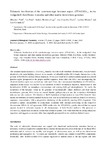Mostrar o rexistro simple do ítem
Telomeric localization of the vertebrate-type hexamer repeat, (TTAGGG) ₙ, in the wedgeshell clam "Donax trunculus" and other marine invertebrate genomes
| dc.contributor.author | Plohl, Miroslav | |
| dc.contributor.author | Prats, Eva | |
| dc.contributor.author | Martínez-Lage, Andrés | |
| dc.contributor.author | González-Tizón, Ana M. | |
| dc.contributor.author | Méndez, Josefina | |
| dc.contributor.author | Cornudella, Luis | |
| dc.date.accessioned | 2020-06-26T17:54:59Z | |
| dc.date.available | 2020-06-26T17:54:59Z | |
| dc.date.issued | 2002-05-31 | |
| dc.identifier.citation | Telomeric localization of the vertebrate-type hexamer repeat, (TTAGGG) ₙ, in the wedgeshell clam "Donax trunculus" and other marine invertebrate genomes. Miroslav Plohl, Eva Prats, Andrés Martínez-Lage, Ana González-Tizón, Josefina Méndez and Luis Cornudella, J Biol. Chem., 277(22), 2002, 19839–19846. | es_ES |
| dc.identifier.issn | 1083-351X | |
| dc.identifier.uri | http://hdl.handle.net/2183/25807 | |
| dc.description.abstract | [Abstract]: The hexamer repeat sequence (TTAGGG) n, found at the ends of all vertebrate chromosomes, was previously identified as the main building element of one member of aHindIII satellite DNA family characterized in the genome of the bivalve mollusc "Donax trunculus". It was also found in 22 perfect tandem repeats in a cloned junction region juxtaposed to the proper satellite sequence, from which the DNA tract encompassing the clustered tandem copies was excised and subcloned. Here, the chromosomal distribution of (TTAGGG) n sequences in the "Donax" was studied by the sensitivity to Bal31 exonuclease digestion, fluorescence in situ hybridization (FISH) on metaphase chromosomes and rotating-field gel electrophoresis. To verify the occurrence of the hexamer repeat in the genomes of taxonomically related molluscs and other marine invertebrates, genomic DNA from the mussel "Mytilus galloprovincialis" and the echinoderm "Holothuria tubulosa" was also analyzed. The kinetics of Bal31 hydrolysis of high molecular mass DNA from the three marine invertebrates revealed a marked decrease over time of the hybridization with the cloned (TTAGGG)22 sequence, concomitantly with a progressive shortening of the positively reacting DNA fragments. This revealed a marked susceptibility to exonuclease consistent with terminal positioning on the respective chromosomal DNAs. In full agreement, FISH results with the (TTAGGG) 22 probe showed that the repeat appears located in telomeric regions in all chromosomes of both bivalve molluscs. The presence of (TTAGGG) n repeat tracts in marine invertebrate telomeres points to its wider distribution among eukaryotic organisms and suggests an ancestry older than originally presumed from its vertebrate distinctiveness. | es_ES |
| dc.description.sponsorship | España. Dirección General de Enseñanza Superior; PB97-1136 | es_ES |
| dc.description.sponsorship | Cataluña. Direcció General de Recerca; SGR01-354 | es_ES |
| dc.language.iso | eng | es_ES |
| dc.publisher | American Society for Biochemistry and Molecular Biology | es_ES |
| dc.relation.uri | https://doi.org/10.1074/jbc.M201032200 | es_ES |
| dc.rights | This is a post-peer-review, pre-copyedit version of an article published in [Journal of Biological Chemistry]. The final authenticated version is available online at: [doi: 10.1074/jbc.M201032200]. | es_ES |
| dc.title | Telomeric localization of the vertebrate-type hexamer repeat, (TTAGGG) ₙ, in the wedgeshell clam "Donax trunculus" and other marine invertebrate genomes | es_ES |
| dc.type | info:eu-repo/semantics/article | es_ES |
| dc.rights.access | info:eu-repo/semantics/openAccess | es_ES |
| UDC.journalTitle | Journal of Biological Chemistry | es_ES |
| UDC.volume | 277 | es_ES |
| UDC.issue | 22 | es_ES |
| UDC.startPage | 19839 | es_ES |
| UDC.endPage | 19846 | es_ES |
Ficheiros no ítem
Este ítem aparece na(s) seguinte(s) colección(s)
-
GI-GIBE - Artigos [83]






